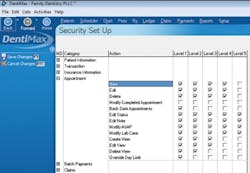Justin Moody, DDS
For more on this topic, go to www.dentaleconomics.com and search using the following key words: dental technology, digital imaging, CBCT, orthodontics, Justin Moody, DDS.
In this changing economy, creating new avenues for expanding our patient base can be integral to a growing practice. Over the years, I have realized that my patients would better be served, as the song goes, “with a little help from my friends” ... or with a little help from my colleagues, as well as the new technologies that help us work better together.
As a general dentist, I have always strived to provide the best care to my patients. To add treatment choices, I developed a core of implant options. However, to provide a full spectrum of specialty services such as orthodontics, I have invited an orthodontist, Dr. Sami Webb, to work in my Crawford, Neb., office. Dr. Webb, an experienced orthodontist, travels between her own main office and one other satellite office in addition to working in my Crawford office.
Working in conjunction with an orthodontist is a win-win situation for both of us doctors and our patients. The majority of our collaborations are on cosmetic and implant cases. Not only can we create the proper spaces and esthetic results, we can move our patients’ teeth orthodontically into the correct position to facilitate implant and/or no-prep veneers. Patients appreciate that we don’t have to destroy any tooth structure to achieve results with this conservative approach.
With patients who have congenitally missing or traumatically lost teeth, we work together to create and maintain the proper space until the patient is old enough to receive an implant. I have seen cases where the patient gets his or her braces removed, but when it is time to place the implants, the teeth have drifted, requiring further orthodontics. When the orthodontist and I work together from the beginning of the case, our focus is to do it once, and do it right.
Technology helps both with the placement of implants and with the orthodontics. Having the proper dental imaging makes our results even more predictable. My i-CAT® 3-D imaging system (Imaging Sciences) helps me to prepare the implant site with data I can use to assess bone height, width, quality, pathology, root locations and proximity to adjacent teeth, and location of the nerves.
The orthodontist benefits from the precise root positions visible on the 3-D scan’s volumetric view, when indicated, as well as the 2-D digital pan. To help us achieve ALARA, we can reduce radiation exposure through collimation and the 4.8-second lower-dose scan. Then, we can still obtain the more detailed information not available from a 2-D radiographic option for a more successful outcome.
Since our practice is located in a rural area, many patients drive several hours for their orthodontic care. Without Dr. Webb in my office, many would not consider driving an even farther distance, and thus would not seek dental care at all. Joining forces with an orthodontist makes financial sense to me.
The orthodontist pays a reasonable amount of rent instead of the overhead of another office, and we share technology, such as CBCT, that helps us plan more precisely. Together, we can do it once, and do it right!
Dr. Justin Moody is a diplomate with the American Board of Oral Implantology/Implant Dentistry and the International Congress of Oral Implantologists, and an associate fellow with the American Academy of Implant Dentistry. He also holds mastership and fellow status at the Misch International Implant Institute. He can be reached at [email protected].







